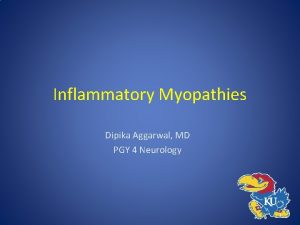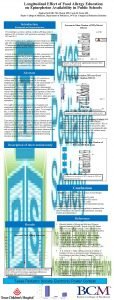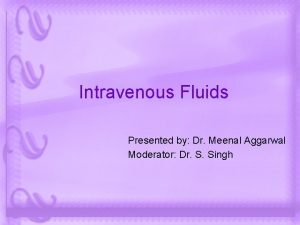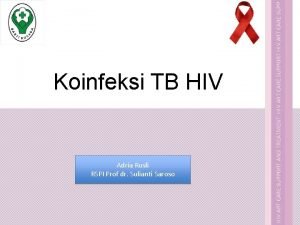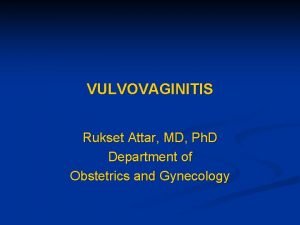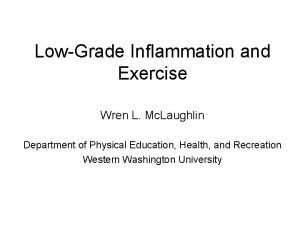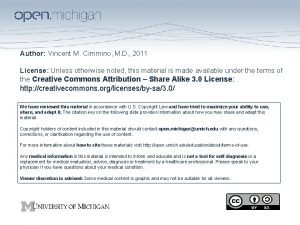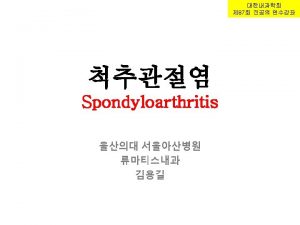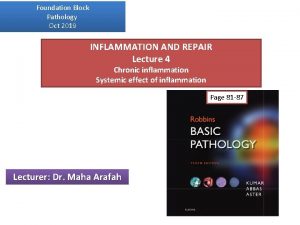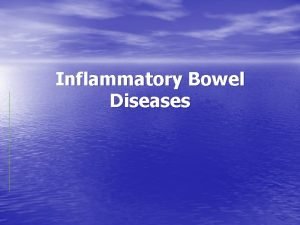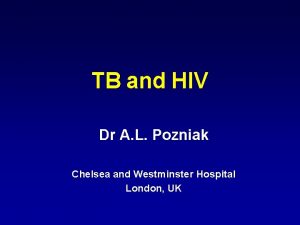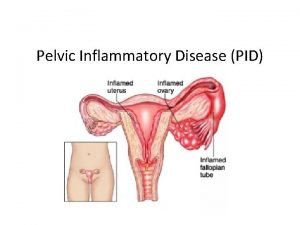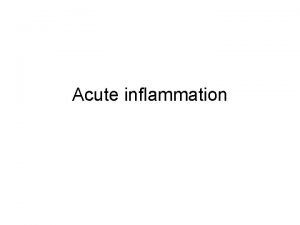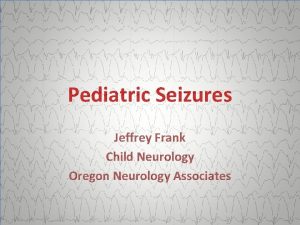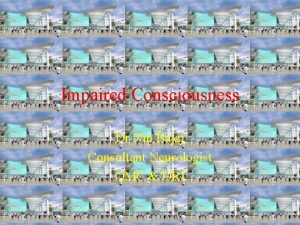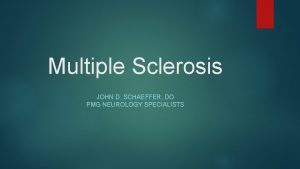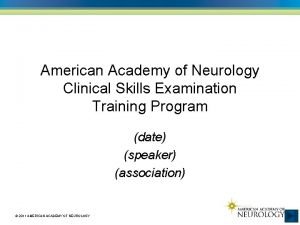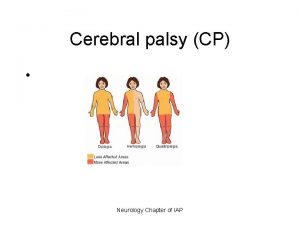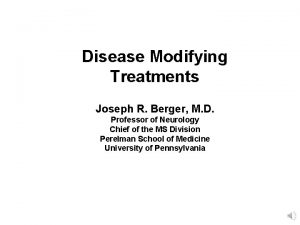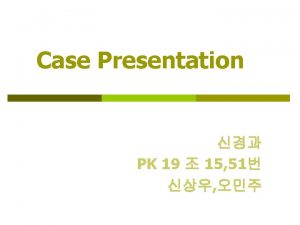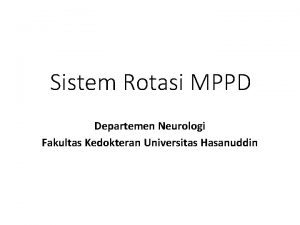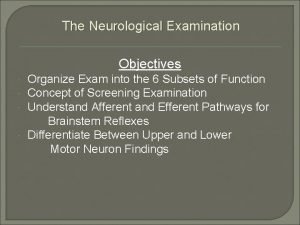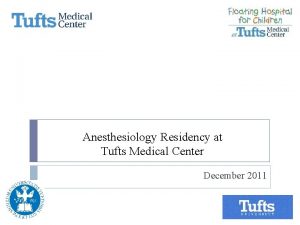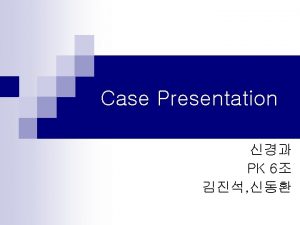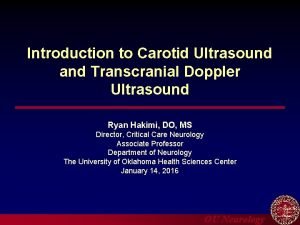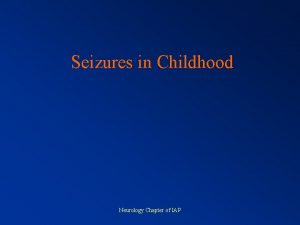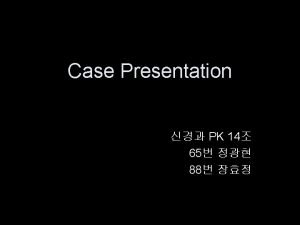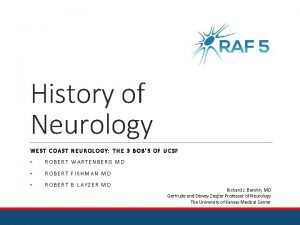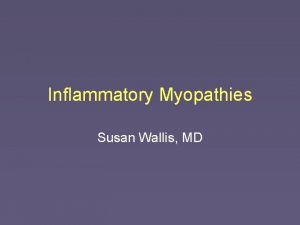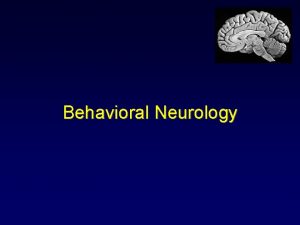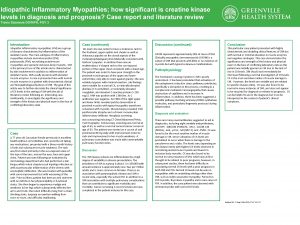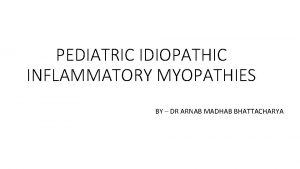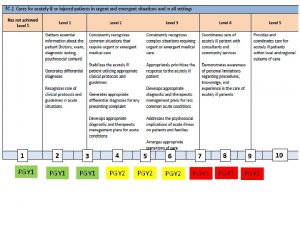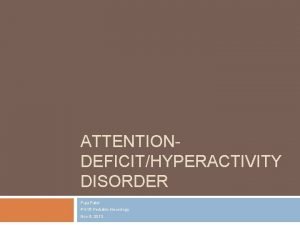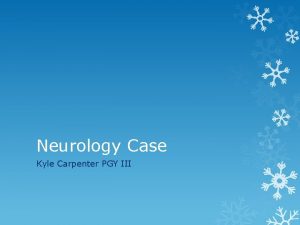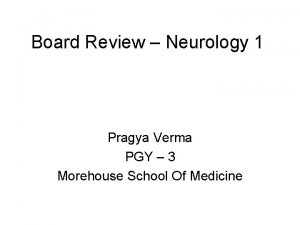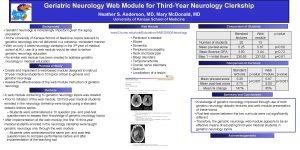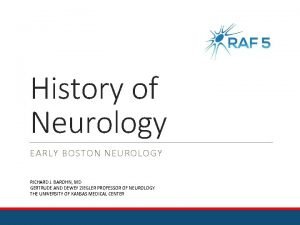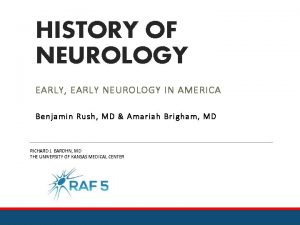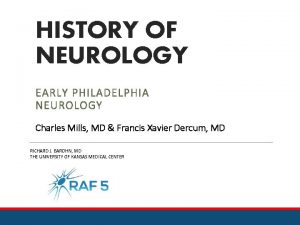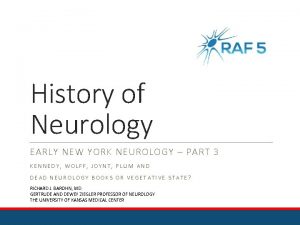Inflammatory Myopathies Dipika Aggarwal MD PGY 4 Neurology

















































- Slides: 49

Inflammatory Myopathies Dipika Aggarwal, MD PGY 4 Neurology 1

Idiopathic Inflammatory Myopathies • • Dermatomyositis (DM) Polymyositis (PM) Autoimmune Necrotizing Myopathy (NM) Inclusion Body Myositis (IBM) 2

Idiopathic Inflammatory Myopathies Epidemiology • Annual incidence – 1: 100, 000 • Incidence of individual myositides has been limited by the different diagnostic criteria employed in various epidemiological studies • IBM is the most common myopathy after age 50 with prevalence of 3. 5/100, 000 cases • Disease of adults (except for Juvenile DM) • Women are more commonly affected • Genetic predisposition secondary to inherited Human Leukocyte Antigens (HLA) haplotypes 3

Idiopathic Inflammatory Myopathies 4

Idiopathic Inflammatory Myopathies 5

Dermatomyositis (DM) • Can present at any age, including infancy • Affects female more than males • Acute (over several weeks) or insidiously (over months) progressive, painless, proximal weakness with or without characteristic skin rash • Proximal leg and arm muscles are usually the earliest and most severely affected muscle groups • Mostly painless • Speech, chewing and swallowing difficulties may be seen • JDM commonly presents after a febrile episode and with a skin rash • Multisystem involvement is more common in JDM 6

Dermatomyositis : Skin involvement • • • Distinct rash Occurs before or with the onset of muscle weakness Variable degree of muscle versus skin involvement Amyopathic DM– isolated rash with no muscle involvement Adermatopathic DM – isolated myositis Classical DM findings: – – – heliotrope rash Gottron’s papules dilated nail bed capillaries V-sign shawl sign mechanic’s hands • Subcutaneous calcinosis seen in 30 -70% cases of JDM, less common in adults 7

DM : Skin findings Heliotrope rash: purplish discoloration along the hairline of scalp and malar region of the face and eyelids Dilated capillary loops evident in the nail bed as well as small ulceration involving the distal aspect of the little finger 8

DM : Skin findings Gottron papules : erythematous lichenoid papular scaly rash, over the extensor surface of the hands and fingers 9

DM : Skin findings V sign: Erythematous rash around face, neck and anterior chest Shawl sign: erythematous rash affecting upper back 10

DM : Skin findings Mechanic’s hands: Cracking of the finger pad skin, commonly involving the first, second, and third fingers 11

Dermatomyositis – Lab features • Serum CK – Elevated serum CK with levels ranging upto 50 times the upper limit of normal – CK level may be normal in less than 10% pts – Do not co-relate with the severity of weakness • ANA is detected in 24 -60% of pts with DM • Myositis specific antibodies – Found in a minority of patients – Useful in predicting response to therapy and prognosis – Cytoplasmic antibodies directed against transitional proteins (t. RNA synthetases and anti-signal recognition particle) – Directed against nuclear proteins (Mi-2 and Mas antigens) – Most common MSA are Jo-1 antibodies, associated with Interstitial Lung Disease, seen in 20% pts (MTX should be avoided) – Mi-2 antibodies (15 -20% DM pts); associated with acute onset, florid rash, good response to therapy and favourable prognosis 12

Dermatomyositis - Electrophysiology • Motor and sensory nerve conduction studies are mostly normal • Needle examination shows non specific findings of irritative myopathy (increased insertional activity, fibrillation potentials and positive sharp waves, complex repetitive discharges) • Muscle fibrosis in advanced cases may result in reduced insertional activity due to fibrosis • Motor unit action potentials (MUAPs) are polyphasic, brief, and of low amplitude • EMG is helpful in assessing relapsing weakness during treatment • Worsening strength in the absence of fibrillation potentials suggests a steroid induced myopathy 13

Dermatomyositis Histopathology and Pathogenesis • Histology – Earliest finding : Membrane Attack Complexes around blood vessels – Pathognomic : perifascicular atrophy with or without perimysial and perivascular inflammatory infiltrate (macrophages , B cells , CD 4+ T cells , plasmacytoid dendritic cells) – Electron microscopy: tubulo reticular inclusions in the intramuscular arterioles and capillaries • Pathogenesis – Humorally mediated micro angiopathy – antibodies directed against endothelial cells activate complement factors membrane attack complex (MAC) deposition on capillaries endothelial damage, capillary necrosis, perivascular inflammation, ischemia and myofibril necrosis 14

Muscle Biopsy Perifascicular atrophy with perimysial inflammation MAC deposition around blood vessels (Immunoperoxidase stain) 15

Muscle Biopsy 16

Idiopathic Inflammatory Myopathies 17

Polymyositis (PM) • Exclusionary diagnosis in pts who do not have a rash or alternate muscle or nerve disease • PM is a disease of adults over age 20 years • More prevalent in female • Subacute to insidiously progressive, proximal arm and leg weakness • Myalgias and tenderness are common but usually not the first presenting symptoms • Dysphagia is seen in one-third of patients • Facial weakness is occasionally present 18

Polymyositis – work up • Elevated CK in range of 5 to 50 times the normal. Unlike DM, CK is always elevated in PM • Positive ANA (16 -40% ) • Myositis specific antibodies – useful in predicting response to therapy and prognosis – Anti SRP antibodies: severe, fulminant, steroid resistant PM – Anti Jo-1 antibodies: associated with ILD • Electro diagnostic tests show evidence of muscle irritation – Increased insertional activity, positive sharp waves, polyphasic MUAPs – Do not distinguish PM from other IIM • Skeletal muscle MRI – increased signal consistent with muscle edema and inflammation 19

Polymyositis Histopathology and Pathogenesis • Histology – fiber size variability – scattered necrotic and regenerating fibers – endomysial inflammation consisting of cytotoxic T cells and macrophages • Pathogenesis – HLA- restricted, antigen specific, cell mediated immune response directed against muscle fibers – ? ? Trigger • viral infections (inconclusive hypothesis) • MHC 1 expressed endogenous peptide “auto antigen” activation of CD 8+ cytotoxic T cells and macrophages that invade myocytes destroy muscle fibres through perforin pathway causing pore formation and osmolysis – Unlike DM - MAC, complement or immuno globulins are not deposited on the microvasculature in PM 20

Muscle Biopsy Endomysial inflammatory cell infiltrate surrounding and invading non necrotic muscle fibres 21

Idiopathic Inflammatory Myopathies 22

Autoimmune Necrotizing Myopathy (NM) • • • Increasing recognized autoimmune myopathy little or no inflammatory infiltrate more common in females sub acute progressive proximal weakness without rash rapid onset than PM; markedly severe in 30% cases myalgia and dysphagia 23

Autoimmune Necrotizing Myopathy Subtypes • Paraneoplastic NM – rare, rapidly progressive – severe variant – associated with adenocarcinoma • NM with thick “pipestem” capillaries – associated with subacute weakness – brain infarction due to vascultis – Connective Tissue Disease • SRP autoantibodies associated NM – Severe, fulminant – treatment refractory – cardiac complications (myocarditis) • Statin induced autoimmune NM (SANAM) – affects between 46 to 89 year old pts – onset may be delayed upto 10 yrs following statin initiation – may occur several months after discontinuation – Often therapy resistant 24

Autoimmune Necrotizing Myopathy – work up • • Elevated CK – more than 10 times the normal Positive ANA – suggestive of underlying CTD MSA – SRP autoantibodies EMG – irritative myopathy 25

NM - Histopathology and Pathogenesis • Histology – Scattered necrotic myofibers with myophagocytes – Absence or paucity of T-lymphocytic inflammation – Unlike DM, perivascular inflammation is scant, and there are no endothelial tubulo reticular inclusions – Thick-walled and enlarged “pipestem” capillaries is diagnostic of NM with pipestem capillaries – SRP-associated NM: bimodal distribution of fiber sizes, increased endomysial connective tissue, and reduced endomysial capillary number with enlargement and thickening • Pathogenesis – Unknown – deposition of complement MAC on small arterioles and capillaries with thickened endothelial walls suggests humorally mediated microangiopathy – Anti 200/ 100 antibodies • Autoantigen is 3 -hydroxy -3 - methylglutaryl-coenzyme A reductase (HMGCR) protein • Statin upregulate HMGCR protein levels, thus triggering anti- HMGCR auto immunity 26

Muscle Biopsy Scattered necrotic fibers, some undergoing phagocytosis 27

Associated conditions • There is an increased incidence of interstitial lung disease, autoimmune disorders, cancer and cardiac disorders in patients with DM , PM and NM • Cardiac – – conductions defects, arrhythmias ventricular and septal wall motion abnormalities Pericarditis and congestive heart failure (less common) Myocarditis (seen in 1/3 rd pts), associated SRP autoantibodies • Pulmonary – – 10 -25% of patients have ILD Jo-1 antibodies are present in at least 50% of ILD cases Prompt chest imaging and pulmonary function tests Pulmonary consultation 28

Associated conditions (contd. ) • Malignancy – Most studies suggest 15 to 25% of adult DM patients, older than 40 years, have preexisting, concurrent, or future malignancies – Most common DM-associated malignancy • Women: ovarian cancer • Men: small cell lung cancer – Other common malignancies are – pancreatic cancer, stomach and colorectal cancers and lymphoma – Rarely, malignancy has been reported in JDM – Malignancy is increased in PM and NM when compared with the general population – Routine screening with careful skin examination for melanoma; CT scan of chest, abdomen and pelvis; and in women, mammogram and pelvic exam; in men, testicular and prostate examinations • If primary screening is negative, repeat screening is recommended after 36 months; thereafter every 6 months for 4 years – Treatment of the malignancy improves muscular involvement 29

Associated conditions (contd. ) • Gastro-intestinal system – Dysphagia, aspiration and delayed gastric emptying due to smooth and skeletal muscle weakness – Vasculopathy affecting the GI tract may cause bowel ischemia, necrosis and perforation more commonly seen in JDM • Joints – Polyarthritis has been reported in up to 45% of patients with PM 30

Treatment Immunosuppressive therapy is the mainstay of treatment First line Second line Third line/ Emerging drugs • Prednisone • IV Methylprednisone • Methotrexate • Azathioprine • Intravenous Immunoglobulins • Mycophenolate • Cyclosporine • Tacrolimus • Rituximab • Etanercept • Cyclophosphamide 31

First line: Corticosteroids • No controlled trails • Usual dosing schedule – 1 mg/kg/day or 60 -100 mg daily for 2 -4 weeks followed by every other day schedule – Slower taper in more severe disease – Intravenous steroids may be used in more severe cases initially followed by a slower taper • response to therapy seen in 2 -3 months • no improvement is seen in 4 -6 months or concerns for side effects or exacerbation during the taper , add second line agents • Special points – CXR, PPD – screening; if PPD positive initiate Rx with isoniazid – DEXA at baseline and every 6 months; if bone density < 1. 0 SD initiate Rx with alendronate 32

Second line of management Steroid sparing agents Methotrexate - Antifolate drug; inhibits lymphocyte proliferation - Initial dose of 7. 5 mg weekly, upto 25 mg per week; therapeutic effect after 4 -8 weeks - Side effects : myelosuppression, liver/ renal toxicity, interstitial pneumonitis, stomatitis, teratogenicity - Contra indications: Presence of Anti Jo-1 antibodies or ILD, severe renal/ hepatic impairement, pregnancy - Special points: folate co-administration, monitor CBC and LFT routinely, monitor PFTs at baseline and every 6 months Azathioprine - Antimetabolite; blocks T cell proliferation - Usual dose: 2 to 3 mg/kg/day ranging from 100 to 250 mg / day - Delayed therapeutic response, 4 -8 months (peaks at 1 -2 years) - Side effects: myelosuppression, liver toxicity, acute hypersensitivity reaction/ flu like illness (12%), pancreatitis, teratogenicity - Contra indications: Pregnancy - Special points: monitor CBC and LFT every 2 weeks until stable dose, then once monthly; if leukopenia then decrease dose; if LFTs elevated x 2 then discontinue 33

Second line of management Steroid sparing agents Intravenous Immunoglobulins - complex immuno modulatory mechanism of action: reduced autoantibody production and binding, suppression of pro inflammatory cytokines - AAN guideline recommend IVIg as possibly effective for non responsive DM - Dose: initial dose of 2 g/kg divided over 2 to 5 days. Maintenance dosing of 0. 4 to 2 g/kg per month administered every 1 to 4 weeks - Side effects: Flu like illness, headache, aseptic meningitis, risk of renal failure and thrombosis - Contra indications: Immunoglobulin A deficiency, renal insufficiency, significant atherosclerotic disease - Special points: very expensive Mycophenolate mofetil - Inhibits proliferation of T and B lymphocytes by blocking purine synthesis - Dose: 1 to 1. 5 gm twice daily - Side effects: myelosuppression, diarrhea, HTN, tremor - Contra indications : myelosuppression, pregnancy 34

Third line • Cyclosporine • Cyclophosphamide • Tacrolimus • Recent drug trials – Dose: 3 to 4 mg/kg per day; max 6 mg/kg/day – C/I: HTN, renal dysfunction, malignancy, pregnancy – S/E: HTN, renal failure, gingival hyperplasia, GI upset – Monitor BP, renal function, drug level – Dose: 2 mg oral titrated to clinical response/ tolerance – C/I: ILD and Anti Jo-1 antibodies, renal/ hepatic impairement – S/E: diarrhea, headache, tremors, insomnia, lymphoma – Dose: 1 -2 mg/kg per day – C/I: myelosuppression, pregnancy – S/E: hemorrhagic cystitis, alopecia, GI upset – High fluid intake, monitor UA and CBC closely – Etanercept – Rituximab 35

Recent drug trials Randomized, Pilot Trial of Etanercept in Dermatomyositis; Muscle Study Group (Amato, et al) Neurology 2011 • • • Etanercept: Tumor necrosis factor α inhibitor Randomized, double blind, placebo controlled trial 16 subjects randomized: 11 – etanercept; 5 – placebo Duration of study: 52 weeks Etanercept: 50 mg subcutaneous weekly All subjects tapered off prednisone over 24 weeks Outcome measures: adverse events, time from randomization to failure, average prednisone dose at 24 weeks Results: – All 5 Placebo subjects: failed (median 148 days) – 6/11 Etanercept subjects: failed (median 358 day) – 5/11 Etanercept subjects: successfully tapered off Prednisone – Average prednisone dosage after 24 weeks lower in etanercept group (1. 2 mg/day) as compared to placebo group (29. 2 mg/day) Conclusion: Etanercept may have steroid sparing effect; need further study 36

Recent drug trials Rituximab in the Treatment of Refractory Adult and Juvenile Dermatomyositis and Adult Polymyositis. Oddis et al, 2011 • • Rituximab: B cell depleting agent Randomized, double blind, placebo phase trial 195 subjects with refractory disease (76 PM, 76 DM and 48 JDM) Duration of study: 44 weeks 2 groups: – Group A ( Rituximab early) – Group B ( Rituximab started 8 weeks later) Outcome measures: – Primary end point: time to achieve definition of improvement – Secondary end point: time to achieve 20% improvement in muscle strength Results – No significant difference in Group A and B in primary end point (20. 2 and 20 weeks respectively) – No difference in secondary end point – 83% of subjects met the primary end point/ DOI following Rituximab treatment Conclusion: The role of B cell depleting therapies in myositis warrants further study 37

Otherapies • Diet and lifestyle – Dietary supplementation has limited role – Oral creatine may be of potential benefit • Assistive devices – Single prong cane, Rolling walker, wheelchair to prevent falls • Physical therapy – To maintain strength and address ADLs – Early mobilization to prevent flexion contractures of large joints 38

Prognosis • • The prognosis of the idiopathic inflammatory myopathies is generally favorable Overall, drug-free remissions are rare except in JDM Poor prognostic factors – old age – male gender – non-Caucasian ethnicity – longer symptom duration – ILD, cardiac involvement – associated malignancy – dysphagia – serum MSA (anti Jo-1 antibodies, anti SRP antibodies) Mortality remains two- to three fold higher than the general population; with cancer, lung, cardiac complications, and infections being the most common causes of death 39

Idiopathic Inflammatory Myopathies 40

Inclusion body myositis (IBM) • Most common inflammatory myopathy after age 50 yrs • Insidious onset, slowly progressive proximal leg and distal arm weakness • Delayed diagnosis with average duration of symptoms prior to diagnosis is 6 -7 yrs • Male are affected more than female • Hallmark: weakness and atrophy (2/3 rd of the pts) – Legs: knee extensors, ankle dorsiflexors – Arms: wrist and finger flexors • Upto 82% of patients have marked asymmetry • Sparing of thenar and hypothenar muscles helps distinguish IBM from ALS • Dysphagia occurs on 70% patients • Mild to moderate facial weakness 41

IBM marked difficulty in flexing the fingers of the left hand as compared to the right Quadriceps atrophy 42

IBM – work up • Serum CK may be normal or elevated up to 10 times normal • ANA positive in 20% patients • Nerve conduction studies - mild sensory axonal peripheral polyneuropathy in up to 30% of patients with IBM • Needle examination - evidence of muscle irritation (increased insertional activity, positive sharp waves, polyphasic potentials) • Skeletal muscle MRI scans – atrophy and signal abnormalities in affected muscle groups 43

IBM - Histopathology and Pathogenesis • Histology – Endomysial inflammation – Small group of atrophic fibers – Eosinophilic cytoplasmic inclusions ( better visualized with immunostain directed against phosphorylated tau) – Multiple myofibers with one or more rimmed vacuoles lined with granular material (likely amyloid deposition-Congo Red stain) • Pathogenesis ; unknown – Autoimmune - presence of inflammatory cells on histology (cytotoxic T cells, myeloid dendritic cells, B cells and IBM autoantibody) – Degenerative - no response to immunotherapy, presence of protein aggregates (amyloid, hyperphosphorylated tau, neurofilament heavy chain) within rimmed vacuolated muscle fibers 44

Muscle Biopsy H&E stain Vacuole filled with granules (Modified Gomori trichrome stain) 45

Treatment • Refractory to all treatments • Various RCT of IVIg with or w/o steroids, MTX, beta interferon, etanercept did not show any benefit • Some patients may have transient and mild improvement with corticosteroids and exercise therapy early on in the course of the disease • Several novel therapies are being evaluated – lithium chloride, arimoclomol, follistatin gene transfer therapy • Arimoclomol: potent heat shock protein 70 inducer – Inducing HSP levels may reverse the toxic cellular changes – Recent two-center trial (KU and University College London) was conducted to assess the safety and tolerability of Arimoclomol in IBM as compared to placebo over 4 months of treatment – Arimoclomol is well tolerated in this study population 46

Prognosis • Associated conditions – Unlike DM &PM, IBM is not associated with myocarditis, lung disease and malignancy – 15% pts have underlying autoimmune CTD like SLE, Sjogren’s, Scleroderma and sacrcoidosis • Prognosis – Life expectancy not significantly altered – Most patients are wheelchair bound by 10 -15 years 47

References • • • Dimachkie MM, Barohn RJ. Idiopathic inflammatory myopathies. Semin Neurology 2012; 32: 227 -236 Dimachkie MM, Barohn RJ. Inclusion Body Myositis. Semin Neurology 2012; 32: 237 -245 Dimachkie MM. Idiopathic Inflammatory Myopathies. Journal of Neuroimmunology 231 (2011): 32 -42 Amato AA, Russell JA. Inflammatory Myopathies. Neuromuscular Disorders 2008; Chapter 30: 681 -713 Distad BJ, Amato AA. Inflammatory myopathies. Current Treatment Options in Neurology (2011) 13: 119 -130 Oddis CV, Reed AM. Rituximab in the Treatment of Refractory Adult and Juvenile Dermatomyositis and Adult Polymyositis. Athritis and Rheumatism, 2013, Vol 65, 314 -324 Amato AA. Randomized, Pilot Trial of Etanercept in Dermatomyositis; Muscle Study Group. Neurology 2011; 70: 427 -436 Dalakas MC, Hohlfeld R. Polymyostis and Dermatomyositis. The Lancet 2003; Vol 362: 971982 Titulaer MJ, Soffietti R, Dalmau J, et al. Screening for tumours in paraneoplastic syndromes: report of an EFNS task force. Eur J Neurol 2011; 18(1): 19–e 3 Amato AA, Barohn RJ. Evaluation and treatment of inflammatory myopathies. J Neurol Neurosurg Psychiatry 2009; 80: 1060 – 1068 http: //neuromuscular. wustl. edu Miller FW. Myositis-specific autoantibodies: touchstones for understanding the inflammatory myopathies. JAMA 1993; 270: 1846 -1849 48

49
 Dipika aggarwal
Dipika aggarwal Dipika patel md
Dipika patel md Shelley aggarwal
Shelley aggarwal How does normal saline cause acidosis
How does normal saline cause acidosis Falguni aggarwal
Falguni aggarwal Ifrs def
Ifrs def Predeksihkhariini
Predeksihkhariini Mucorrhea causes
Mucorrhea causes Pro and anti inflammatory
Pro and anti inflammatory Treatment of inflammatory breast cancer
Treatment of inflammatory breast cancer Pelvic inflammatory disease men
Pelvic inflammatory disease men Mechanical pain
Mechanical pain Inflammatory cells
Inflammatory cells Paul charlson
Paul charlson Maxillofacial area inflammatory diseases
Maxillofacial area inflammatory diseases Types of colitis
Types of colitis Immune reconstitution inflammatory syndrome
Immune reconstitution inflammatory syndrome Pelvic girdle pain
Pelvic girdle pain Inflammatory breast cancer
Inflammatory breast cancer Pus smear
Pus smear Miqtu
Miqtu Dr bajaj neurologist
Dr bajaj neurologist Pmg neurology
Pmg neurology Uf neurology residents
Uf neurology residents Umass nurse residency program
Umass nurse residency program Nex exam neurology
Nex exam neurology Pediatric shelf percentiles
Pediatric shelf percentiles The walton centre for neurology and neurosurgery
The walton centre for neurology and neurosurgery Cerebral palsy iap
Cerebral palsy iap Neurology near loomis
Neurology near loomis Joseph berger md neurology
Joseph berger md neurology Mary bridge pediatric neurology
Mary bridge pediatric neurology Midwest neurology
Midwest neurology Nlff neurology
Nlff neurology Department of neurology
Department of neurology Neuro exam strength
Neuro exam strength Tufts anesthesia residency
Tufts anesthesia residency Nlff neurology
Nlff neurology Difference between doppler and duplex
Difference between doppler and duplex Midwest neurology
Midwest neurology Neurology
Neurology Nlff neurology
Nlff neurology Dr forbes neurology
Dr forbes neurology Dr kirk kleinfeld
Dr kirk kleinfeld Difference between fine touch and crude touch
Difference between fine touch and crude touch Nheent
Nheent Robert layzer md
Robert layzer md Erlanger neurology
Erlanger neurology
